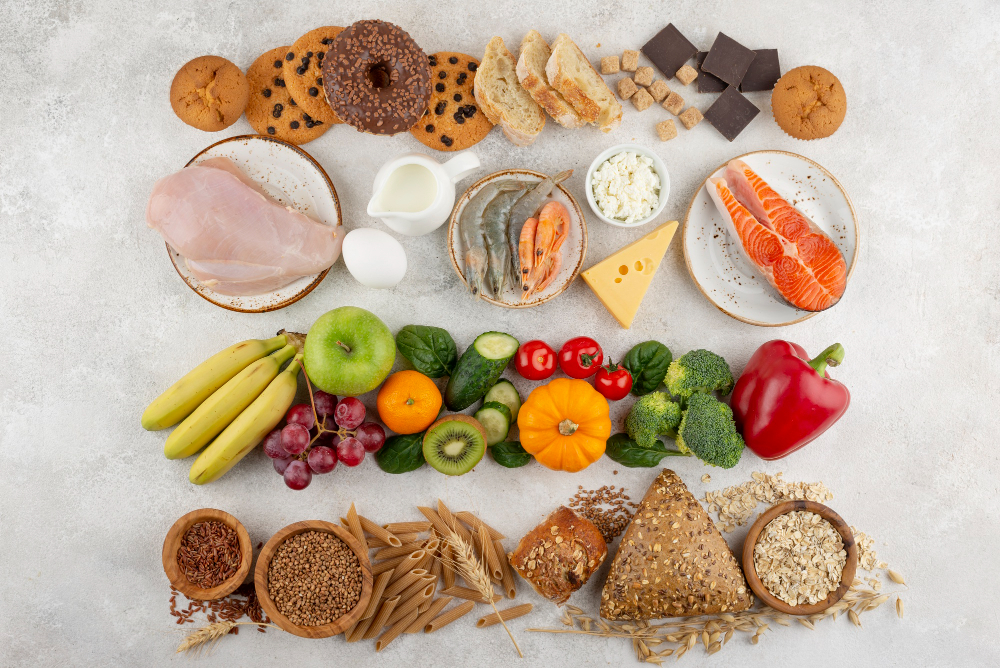Managing diabetes involves paying close attention to your diet to control blood sugar levels. Navigating the realm of nutrition can be particularly daunting for individuals managing diabetes. With blood sugar levels at the forefront of daily concerns, understanding the glycemic index (GI) becomes paramount along with careful planning.
General Guidelines:
1. Portion Control: Keep portion sizes moderate to avoid spikes in blood sugar levels.
2. Balanced Meals: Aim for meals that include a balance of carbohydrates, protein, and healthy fats.
3. Fiber-Rich Foods: Incorporate plenty of fiber-rich foods like vegetables, fruits, legumes, and whole grains to help control blood sugar levels.
4. Limit Sugary Foods: Minimize consumption of sugary foods and beverages, as they can cause rapid spikes in blood sugar.
5. Healthy Fats: Choose sources of healthy fats like avocados, nuts, seeds, and olive oil.
6. Regular Meals: Eat regular meals and snacks throughout the day to help maintain stable blood sugar levels.
7. Hydration: Stay hydrated by drinking plenty of water throughout the day.
Foods to Include:
1. Vegetables:
– Leafy Greens: Spinach, kale, lettuce, etc.
– Non-Starchy Vegetables: Broccoli, cauliflower, bell peppers, carrots, tomatoes, cucumbers, etc.
– Root Vegetables (in moderation): Sweet potatoes, carrots, beets.
2. Fruits:
– Berries: Strawberries, blueberries, raspberries, etc. (lower in sugar compared to other fruits).
– Citrus Fruits: Oranges, grapefruits, lemons, limes.
– Apples: Choose whole fruits over juices.
– Moderate Portions: Limit fruits high in natural sugars like bananas, grapes, and mangoes.
3. Whole Grains:
– Quinoa
– Brown Rice
– Oats
– Whole Wheat: Bread, pasta, and crackers.
– Barley
4. Lean Protein:
– Skinless Poultry: Chicken, turkey.
– Fish: Salmon, mackerel, tuna, sardines (rich in omega-3 fatty acids).
– Legumes: Lentils, chickpeas, black beans.
– Tofu and Tempeh
– Eggs: Including egg whites.
5. Healthy Fats:
– Nuts and Seeds: Almonds, walnuts, chia seeds, flaxseeds.
– Avocados
– Olive Oil
– Fatty Fish: Salmon, trout.
6. Dairy (Choose Low-Fat Options):
– Greek Yogurt: Unsweetened.
– Low-Fat Milk
– Cheese: Moderation is key due to higher fat content.
7. Beverages:
– Water: Plain or infused with fruits/herbs.
– Herbal Tea
– Sparkling Water: Unsweetened.
– Coffee: In moderation, without added sugars.
Foods to Limit or Avoid:
– Sugary Foods: Soda, candy, desserts, pastries.
– Refined Carbohydrates: White bread, white rice, sugary cereals.
– Processed Foods: Fast food, chips, packaged snacks.
– Highly Processed Meats: Hot dogs, bacon, sausage.
– Full-Fat Dairy: High-fat cheese, whole milk.
– Alcohol: Limit consumption and monitor blood sugar levels.
Meal Planning Tips:
1. Breakfast: Include protein (like eggs) and fiber-rich carbohydrates (like whole grain toast or oats).
2. Lunch and Dinner: Fill half your plate with non-starchy vegetables, one-quarter with lean protein, and one-quarter with whole grains or starchy vegetables.
3. Snacks: Opt for protein-rich snacks like Greek yogurt with berries, veggies with hummus, or a handful of nuts.
4. Hydration: Drink water throughout the day and consider choosing low-calorie, unsweetened beverages.
Monitoring and Adaptation:
– Regular Monitoring: Monitor blood sugar levels regularly and adjust your diet and medications as needed.
– Consult a Dietitian: Consider consulting with a registered dietitian who specializes in diabetes management for personalized guidance.
The glycemic index (GI) categorizes foods based on how quickly they raise blood sugar levels. Here are the tiers of GI and examples of foods in each tier:
Low Glycemic Index (GI 1-55):
1. Non-Starchy Vegetables:
– Broccoli
– Cauliflower
– Spinach
– Bell Peppers
– Zucchini
2. Legumes:
– Lentils
– Chickpeas
– Black Beans
– Kidney Beans
– Pinto Beans
3. Whole Grains:
– Quinoa
– Barley
– Steel-Cut Oats
– Bulgur
– Whole Grain Pasta
4. Fruits (in moderation):
– Berries (strawberries, blueberries, raspberries)
– Cherries
– Grapefruit
– Apples
– Pears
5. Nuts and Seeds:
– Almonds
– Walnuts
– Chia Seeds
– Flaxseeds
– Sunflower Seeds
Moderate Glycemic Index (GI 56-69):
1. Whole Fruits (in moderation):
– Oranges
– Grapes
– Kiwi
– Mango
– Pineapple
2. Whole Grain Breads:
– Whole Wheat Bread
– Rye Bread
– Whole Grain Sourdough
3. Starchy Vegetables (in moderation):
– Sweet Potatoes
– Corn
– Peas
– Butternut Squash
– Acorn Squash
High Glycemic Index (GI 70+):
1. Refined Grains:
– White Bread
– White Rice
– Instant Oats
– Cornflakes
– Rice Cakes
2. Processed Foods:
– Sugary Cereals
– Crackers
– Pretzels
– Potato Chips
– Rice Crackers
3. Sugary Foods:
– Candy
– Soda
– Pastries
– Cakes
– Cookies
It’s important to note that while the glycemic index provides valuable information, other factors such as portion size, overall diet composition, and individual metabolic responses also influence blood sugar levels.
By following a balanced and nutritious diet, individuals with diabetes can better manage their condition and improve overall health. Consistency, portion control, and mindful food choices are key to long-term success. Remember to consult with your healthcare provider or a registered dietitian before making significant changes to your diet or lifestyle.

